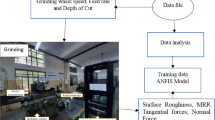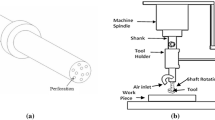Abstract
In this paper, a fuzzy logic artificial intelligence technique is delineate to predict the material removal rate (MRR) and average surface roughness (R a) during abrasive-mixed electro-discharge diamond surface grinding (AMEDDSG) of Nimonic 80A. Though, Nimonic 80A superalloy is extensively used in aerospace and automotive industries due to its high corrosion, fracture toughness, oxidation, and temperature resistance characteristics, being a difficult-to-cut material, its machining is a challenging job. The hybrid machining processes like AMEDDSG can be competently used for machining of Nimonic 80A. The face-centered central composite design is used consummate the experiments and then experimental data are used to establish fuzzy logic Mamdani model to predict the MRR and R a with respect to changes in the input process parameters viz. wheel RPM, abrasive concentration, pulse current and pulse-on-time. The results of confirmation experiments reveal an agreement between the fuzzy model and experimental results with 93.89 % accuracy implying that the established fuzzy logic model can be precisely used for predicting the performance of the AMEDDSG process. An increase in wheel RPM, pulse current, and pulse-on-time from their low level to high level contributes to increased MRR by 83.89, 71.01, 17.02 %, respectively. Also, an increase in wheel RPM contributes to reduced R a values by 5.96 %. Abrasive concentration increase from 0 to 4 g/L improves MRR by 24.03 %. The 17.10 % improvement in surface finish is achieved by increasing abrasive concentration from 0 to 8 g/L.











Similar content being viewed by others
Abbreviations
- MRR:
-
Material removal rate
- R a :
-
Average surface roughness
- AMEDDSG:
-
Abrasive-mixed electro-discharge diamond surface grinding
- HMPs:
-
Hybrid machining processes
- EDG:
-
Electro-discharge grinding
- EDDG:
-
Electro-discharge diamond grinding
- ECDG:
-
Electrochemical discharge grinding
- ECDM:
-
Electrochemical discharge machining
- EDDCG:
-
Electro-discharge diamond cutoff grinding
- EDDFG:
-
Electro-discharge diamond face grinding
- EDDSG:
-
Electro-discharge diamond surface grinding
- EDM:
-
Electro-discharge machining
- HSS:
-
High speed steel
- WC–Co:
-
Tungsten carbide–cobalt
- ANN:
-
Artificial neural network
- ANFIS:
-
Adaptive neuro-fuzzy system
- DC:
-
Direct current
- RSM:
-
Response surface methodology
- PMDC:
-
Permanent magnet direct current
- SiC:
-
Silicon carbide
- MF:
-
Membership function
- RMSE:
-
Root-mean-square error
- VL:
-
Very low
- L:
-
Low
- M:
-
Medium
- H:
-
High
- VH:
-
Very high
- E:
-
Excellent
- G:
-
Good
- A:
-
Average
- B:
-
Bad
- R:
-
Rough
- COA:
-
Centroid of area
- IEG:
-
Inter-electrode gap
References
Unune DR, Mali HS (2014) Current status and applications of hybrid micro-machining processes: a review. Proc Inst Mech Eng B J Eng Manuf 229(10):1681–1693. doi:10.1177/0954405414546141
Pervaiz S, Rashid A, Deiab I, Nicolescu M (2014) Influence of tool materials on machinability of titanium- and nickel-based alloys: a review. Mater Manuf Process 29(3):219–252. doi:10.1080/10426914.2014.880460
Shrivastava PK, Dubey AK (2013) Electrical discharge machining-based hybrid machining processes: a review. Proc Inst Mech Eng B J Eng Manuf 228(6):799–825. doi:10.1177/0954405413508939
Koshy P, Jain VK, Lal GK (1996) Mechanism of material removal in electrical discharge diamond grinding. Int J Mach Tool Manuf 36(10):1173–1185
Choudhury SK, Jain VK, Gupta M (1999) Electrical discharge diamond grinding of high speed steel. Mach Sci Technol 3(1):91–105. doi:10.1080/10940349908945685
Yadav SKS, Yadava V, Narayana VL (2008) Experimental study and parameter design of electro-discharge diamond grinding. Int J Adv Manuf Technol 36(1–2):34–42
Singh GK, Yadava V, Kumar R (2010) Diamond face grinding of WC-Co composite with spark assistance: experimental study and parameter optimization. Int J Precis Eng Manuf 11(4):509–518
Shrivastava PK, Dubey AK (2013) Experimental modeling and optimization of electric discharge diamond face grinding of metal matrix composite. Int J Adv Manuf Technol 69(9–12):2471–2480. doi:10.1007/s00170-013-5190-8
Agrawal SS, Yadava V (2013) Modeling and prediction of material removal rate and surface roughness in surface-electrical discharge diamond grinding process of metal matrix composites. Mater Manuf Process 28(4):381–389
Mali HS, Unune DR, Tiwari S (2014) Modelling and prediction of material removal rate in electrical discharge diamond surface grinding process of INCONEL-718. In: Proceedings of 5th AIMTDR 2014. IIT Guwahati, India, pp 822:821–822:828
Unune DR, Mali HS (2015) Artificial neural network-based and response surface methodology-based predictive models for material removal rate and surface roughness during electro-discharge diamond grinding of Inconel 718. Proc Inst Mech Eng B J Eng Manuf. doi:10.1177/0954405415619347
Modi M, Agarwal G (2012) Design, development & experimental investigation of electro-discharge diamond surface grinding of Ti–6Al–4V. Int J Adv Mater Res 418–420:1478–1481. doi:10.4028/www.scientific.net/AMR.418-420.1478
Modi M, Agarwal G (2013) Powder-mixed electro-discharge diamond surface grinding process: modelling, comparative analysis and multi-output optimisation using weighted principal components analysis. Stroj Vestn J Mech Eng 59(12):735–747. doi:10.5545/sv-jme.2013.1146
Unune DR, Singh VP, Mali HS (2015) Experimental investigations of abrasive mixed electro discharge diamond grinding of Nimonic 80A. Mater Manuf Process. doi:10.1080/10426914.2015.1090598
Pradhan MK, Biswas CK (2010) Neuro-fuzzy and neural network-based prediction of various responses in electrical discharge machining of AISI D2 steel. Int J Adv Manuf Technol 50(5–8):591–610. doi:10.1007/s00170-010-2531-8
Zalnezhad E, Sarhan AAD, Hamdi M (2013) A fuzzy logic based model to predict surface hardness of thin film TiN coating on aerospace AL7075-T6 alloy. Int J Adv Manuf Technol 68(1–4):415–423. doi:10.1007/s00170-013-4738-y
Chandrasekaran M, Muralidhar M, Krishna CM, Dixit US (2009) Application of soft computing techniques in machining performance prediction and optimization: a literature review. Int J Adv Manuf Technol 46(5–8):445–464. doi:10.1007/s00170-009-2104-x
Maher I, Ling LH, Sarhan AAD, Hamdi M (2015) Improve wire EDM performance at different machining parameters - ANFIS modeling. IFAC-PapersOnLine 48(1):105–110
Mahe, I, Eltaib MEH, El-Zahry RM (2006) Surface roughness prediction in end milling using multiple regression and adaptive neuro-fuzzy inference system. In: International conference on mechanical engineering advanced technology for industrial production (MEATIP4). Assiut University, Egypt, pp 614–620
Khanlou HM, Ang BC, Barzani MM, Silakhori M, Talebian S (2015) Prediction and characterization of surface roughness using sandblasting and acid etching process on new non-toxic titanium biomaterial: adaptive-network-based fuzzy inference System. Neural Comput Appl 26(7):1751–1761. doi:10.1007/s00521-015-1833-z
Khanlou HM, Ang BC, Barzani MM (2015) Prediction, modeling and characterization of surface texturing by sulfuric etchant on non-toxic titanium bio-material using artificial neural networks and fuzzy logic systems. Sci Eng Compos Mater. doi:10.1515/secm-2014-0230
Suganthi XH, Natarajan U, Sathiyamurthy S, Chidambaram K (2013) Prediction of quality responses in micro-EDM process using an adaptive neuro-fuzzy inference system (ANFIS) model. Int J Adv Manuf Technol 68(1–4):339–347. doi:10.1007/s00170-013-4731-5
Marani Barzani M, Zalnezhad E, Sarhan AAD, Farahany S, Ramesh S (2015) Fuzzy logic based model for predicting surface roughness of machined Al–Si–Cu–Fe die casting alloy using different additives-turning. Measurement 61:150–161. doi:10.1016/j.measurement.2014.10.003
Khanlou HM, Ang BC, Talebian S, Barzani MM, Silakhori M, Fauzi H (2015) Multi-response analysis in the processing of poly (methyl methacrylate) nano-fibres membrane by electrospinning based on response surface methodology: fibre diameter and bead formation. Measurement 65:193–206. doi:10.1016/j.measurement.2015.01.014
Kumar A, Maheshwari S, Sharma C, Beri N (2011) Analysis of machining characteristics in additive mixed electric discharge machining of nickel-based super alloy Inconel 718. Mater Manuf Process 26(8):1011–1018
Zalnezhad E, Sarhan AAD (2014) A fuzzy logic predictive model for better surface roughness of Ti–TiN coating on AL7075-T6 alloy for longer fretting fatigue life. Measurement 49:256–265. doi:10.1016/j.measurement.2013.11.042
Zimmermann HJ (1985) Fuzzy set theory and its applications. Kluwer Academic Publishers, London
Yadav RN, Yadava V (2015) Application of soft computing techniques for modeling and optimization of slotted-electrical discharge diamond face grinding process. Trans Indian Inst Met. doi:10.1007/s12666-015-0536-6
Yadav SKS, Yadava V (2013) Experimental investigations to study electrical discharge diamond cutoff grinding (EDDCG) machinability of cemented carbide. Mater Manuf Process 28(10):1077–1081
Acknowledgments
The authors would like to thank Advanced Manufacturing and Mechatronics laboratory and Materials Research Center at Malaviya National Institute of Technology, Jaipur for providing facilities for conducting this work.
Author information
Authors and Affiliations
Corresponding author
Appendix
Rights and permissions
About this article
Cite this article
Unune, D.R., Marani Barzani, M., Mohite, S.S. et al. Fuzzy logic-based model for predicting material removal rate and average surface roughness of machined Nimonic 80A using abrasive-mixed electro-discharge diamond surface grinding. Neural Comput & Applic 29, 647–662 (2018). https://doi.org/10.1007/s00521-016-2581-4
Received:
Accepted:
Published:
Issue Date:
DOI: https://doi.org/10.1007/s00521-016-2581-4




